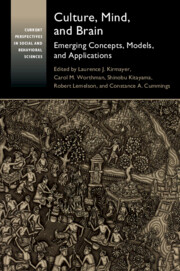Book contents
- Culture, Mind, and Brain
- Current Perspectives in Social and Behavioral Sciences
- Culture, Mind, and Brain
- Copyright page
- Dedication
- Epigraph
- Contents
- Figures
- Tables
- Contributors
- Preface
- Abbreviations
- 1 Introduction
- Part I Dynamics of Culture, Mind, and Brain
- Section 1 The Co-emergence of Culture, Mind, and Brain
- Section 2 The Situated Brain
- Section 3 How Social Coordination and Cooperation are Achieved
- 9 Neuroanthropological Perspectives on Culture, Mind, and Brain
- 10 The Neural Mechanisms Underlying Social Norms
- 11 Ritual and Religion as Social Technologies of Cooperation
- Part II Applications
- Index
- References
9 - Neuroanthropological Perspectives on Culture, Mind, and Brain
from Section 3 - How Social Coordination and Cooperation are Achieved
Published online by Cambridge University Press: 18 September 2020
- Culture, Mind, and Brain
- Current Perspectives in Social and Behavioral Sciences
- Culture, Mind, and Brain
- Copyright page
- Dedication
- Epigraph
- Contents
- Figures
- Tables
- Contributors
- Preface
- Abbreviations
- 1 Introduction
- Part I Dynamics of Culture, Mind, and Brain
- Section 1 The Co-emergence of Culture, Mind, and Brain
- Section 2 The Situated Brain
- Section 3 How Social Coordination and Cooperation are Achieved
- 9 Neuroanthropological Perspectives on Culture, Mind, and Brain
- 10 The Neural Mechanisms Underlying Social Norms
- 11 Ritual and Religion as Social Technologies of Cooperation
- Part II Applications
- Index
- References
Summary
Neuroanthropology is an interdisciplinary approach to studying human variation that integrates brain and cognitive sciences with anthropology and uses theoretically and biologically informed ethnography to examine specific problems at the intersection of brain and culture. This chapter shows how, for instance, the theoretical construct, habitus, can be integrated with accounts of human development and brain enculturation to better understand the internalization of social structures, including how socialization produces both diversity as well as shared outcomes. We also show how ideas from computational neuroscience, such as work on prediction errors and the free energy principle, can augment the understanding of cultural consensus and consonance, or how culture is at once shared and individual. The overarching goal of neuroanthropology is to bolster biocultural exploration of individual enculturation and ground social theory in a more accurate account of individual neurobiology in order to encourage a broader, multidisciplinary study of human cultural variation.
Keywords
- Type
- Chapter
- Information
- Culture, Mind, and BrainEmerging Concepts, Models, and Applications, pp. 277 - 299Publisher: Cambridge University PressPrint publication year: 2020



